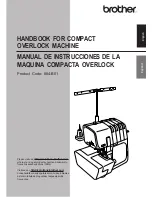Reviews:
No comments
Related manuals for 5060QDC

Solaris VISION BLSA3
Brand: Baby Lock Pages: 20

96-107
Brand: Singer Pages: 41

Scholastic 85SCH
Brand: Singer Pages: 230

OFX8800
Brand: Olivetti Pages: 151

Memory Craft 11000
Brand: Janome Pages: 21

DR-7UW
Brand: NLI Pages: 36

Genie 353
Brand: Singer Pages: 56

GC6180
Brand: typical Pages: 33

Belgafax 802
Brand: BELGACOM Pages: 44

681C
Brand: Necchi Pages: 53

DU-141H-4
Brand: JUKI Pages: 44

M-910
Brand: Muratec Pages: 52

DU-1481 Series
Brand: JUKI Pages: 34

4234DT
Brand: Brother Pages: 80

SP-15
Brand: Koblenz Pages: 8

KX-F580BR
Brand: Panasonic Pages: 30

KX-F560
Brand: Panasonic Pages: 60

KX-F580
Brand: Panasonic Pages: 64

















